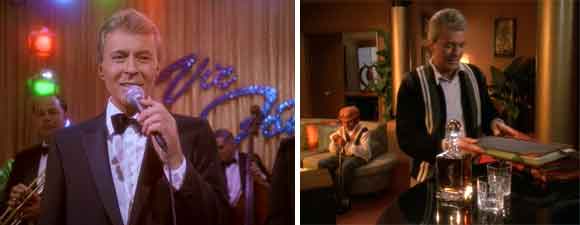Retro Review: Image in the Sand
7 min readAs Kira struggles to run Deep Space Nine with Romulans and without the wormhole, Sisko receives a vision from the Prophets of a mysterious woman.
Plot Summary: Admiral Ross visits DS9 to tell Kira, who has been promoted to colonel during the captain’s three-month absence, that a delegation of Romulans will soon arrive at the station to set up a base of operations. The war has been going in Cardassia’s favor since the wormhole disappeared, and Kira – who is worried about the cult of the Pah-wraiths emerging on Bajor because the orbs are dark – initially appreciates Senator Cretak’s straightforwardness, agreeing to petition Bajor to let the Romulans set up a hospital on a Bajoran moon. Meanwhile, Worf snaps at crewmembers on the Defiant and demands that Vic Fontaine play Jadzia’s favorite song, “All the Way,” in the midst of which Worf begins to smash holographic tables. Concerned, Bashir and O’Brien attempt to find out how to help Worf and learn that he believes Jadzia is not in Sto’Vo’Kor because she did not die in battle. On Earth, Benjamin Sisko has a vision of digging in the desert on Tyree and finding the face of a woman. When he recreates the face on a Padd, Jake recognizes the woman from a photo he found while cleaning out his grandfather’s back room. Joseph initially refuses to speak about the woman, finally admitting that she was Benjamin’s birth mother who abandoned them both shortly after he was born. He still has a necklace that belonged to the woman, on the back of which Benjamin finds an ancient Bajoran inscription describing an Orb of the Emissary not mentioned in other prophecies. The Emissary believes he must find this hidden orb, but is attacked by a member of the Pah-wraith cult who has somehow learned of the orb as well. While he recovers, Kira confronts Cretak about Odo’s discovery that the Romulans have been hiding weapons in their hospital, and Martok asks Worf – joined by Bashir and O’Brien – to come on a dangerous mission to destroy a Dominion shipyard, a valiant quest that should get Jadzia admitted to Sto’Vo’Kor. As the Siskos prepare to leave Earth for Tyree, they are visited by an unfamiliar young Trill who identifies herself as Dax.
Analysis: I don’t think there’s a single moment of “Image in the Sand” that isn’t perfect. If you’re already upset that the Dominion War is taking over Roddenberry’s vision for Star Trek, you’re going to disagree, but within the arcs that have dominated Deep Space Nine, both short-term and long-term, we get an installment full of promise that they will all be brought to fruition, and if we don’t see every single recurring character during these 40 minutes, we do encounter so many that it’s easy to believe we’ll soon be hearing from the rest. The writers do two very brave things: they demonstrate that Kira is entirely capable of commanding the station, that not only Bajor but Starfleet has confidence in her leadership, and they take Sisko back to his roots, not only in his father’s restaurant on Earth but with a mysterious tie to Bajor’s Prophets from before his birth. I get chills when he turns over his mother’s locket and finds Bajoran writing on the back, just as I squeal with glee when Kira barges in on a meeting between Ross and Cretak to reveal that the Romulans are trying to pull one over on Starfleet as well as Bajor. If Worf gets shortchanged a bit – really, we get to see as much of Quark and Bashir mourning for Dax as we do of her husband – that’s sure to be remedied in grandiose Klingon style in the very near future. And it’s very reassuring to see Martok, striding in to do his duty as a Klingon; to see Nog, fretting about how he could die in battle; to see Vic Fontaine, who provides the only real levity of the episode, distressed that his band is threatening to quit even though Quark points out that, as holograms, technically they can’t. So many small threads tie together not only the series but the entire franchise, from complaints about convoy duty to disturbing religious fanaticism to O’Brien’s deep devotion to his friends, not only to Bashir (since it’s for him, not the dead Jadzia, that he agrees to go on a dangerous mission), but to everyone he and Worf knew on the Enterprise.
Sisko has long known that he’s part of something bigger than himself, both as a Starfleet officer and as the Emissary, and it’s hard to blame him when it all becomes too much for him after Jadzia dies and the Prophets seem to have abandoned him, though three months seems like a shockingly long time. To learn suddenly that his own father might have had an inkling of the son’s destiny and chosen to hide it, to give him a normal life and a stable, loving family…it’s easy to forgive Joseph for hiding the name of Benjamin’s biological mother, for never telling his son about the woman who abandoned them both, but once he discovered that his son was also the Emissary to the Prophets, how could he have failed to look more closely at that pendant with the mysterious writing on the back? Of course, it’s because the writers just made this connection up, but the effect of the revelation for the viewer is much like an orb vision for Sisko, rediscovering a distant past to understand the present. Suddenly it seems likely that Sisko didn’t become the Emissary because he entered the wormhole; he entered the wormhole because he was the Emissary, perhaps since his birth. This might all seem a little much like a high fantasy epic if the rest of his life weren’t grounded in such concrete details – playing piano in the French Quarter restaurant where horses and carriages still carry tourists, cleaning shellfish while trying to get his father’s secret gumbo recipe, listening to jazz in Armstrong Park. I’m not in the least sorry we get to see him not as the Starfleet captain or the Emissary, but the man who grew up in New Orleans and made sure that his space-reared son had the same appreciation he does for the culture from which they emerged. So many men on Star Trek are enormously impacted by the legacies of their fathers (Kirk, Spock, Riker, Data, Worf, Odo, Chakotay, Paris, to name just a few) – how fascinating to learn that the biggest influence on Sisko’s life may not have been the father he loves, but the mother whose name he has only just learned.
On which note, I have to talk about Kira and Cretak, two very strong women with drastically different approaches to their roles. When Kira meets the senator, she thinks she may have gotten lucky to have a kindred spirit on the station – someone who’s as willing as she once was to complain about the working conditions, who’s happy to try alien food, whose requests are straightforward and forcefully stated. Then Kira discovers that Cretak may be as duplicitous as Winn. When she confronts the Romulan, however, she is met not with defensiveness or evasion, but a direct statement of Romulan intent and an indication that Cretak has no intention of falling back on titles or demands for respect to go ahead with her plans. Ross looks a little afraid of both of them, particularly since Kira isn’t at all scared to stand up to him, though she’s far less insubordinate than she was to Sisko in early days. Yet Kira also isn’t worried about being downright mushy with Odo, even on the Promenade. They both get nostalgic about their first kiss even though they’re both dealing with a million other things. After so many years of Star Trek giving us only broken relationships and aliens of the week, it is so lovely to see this, although in retrospect it seems obvious all along that the writers always intended for Odo to go back to his own people in the end. On some level, I think Kira may even know that; she may accept it when Odo tells her she turned him into an optimist when she kissed him, but she’s enough of a realist to realize that even she probably won’t be enough for Odo forever. That may be the very reason she let herself fall for him, knowing that in the end she wouldn’t have to break his heart. I’m sorry that Sisko won’t let himself lean on Kasidy Yates yet the way Kira and Odo obviously lean on each other, but he can’t even face Worf’s pain over Dax right now, so it makes sense. I love how it’s all unfolding: the relationships, the conflicts, the struggle to keep the Federation free.







Has always been one oft my favorite Star Trek Episoden. It works in so many levels despite mit beeing an instant “classic“.
I have to admit, there is nothing nicer than a hairy nutsack slapping on my chin when sucking a dude dry 🙂
What a sad life you must have with nothing better than internet trolling you keep you occupied.
https://c1.staticflickr.com/5/4076/4913532594_d72c29aa79_z.jpg
He’s having a much better time than you are posting an angry reply, so really, who is sadder?
There’s nothing angry about my reply. Thanks for your input though!
So Michelle thinks this episode is perfect? So glad I already hated it, I absolutely hate any and all stories involving that idiotic “the whole thing is a story written by a persecuted man in the past”, it is just so unremittingly bad. Surprisingly I don’t hate Ezri.
Superb episode and good review.